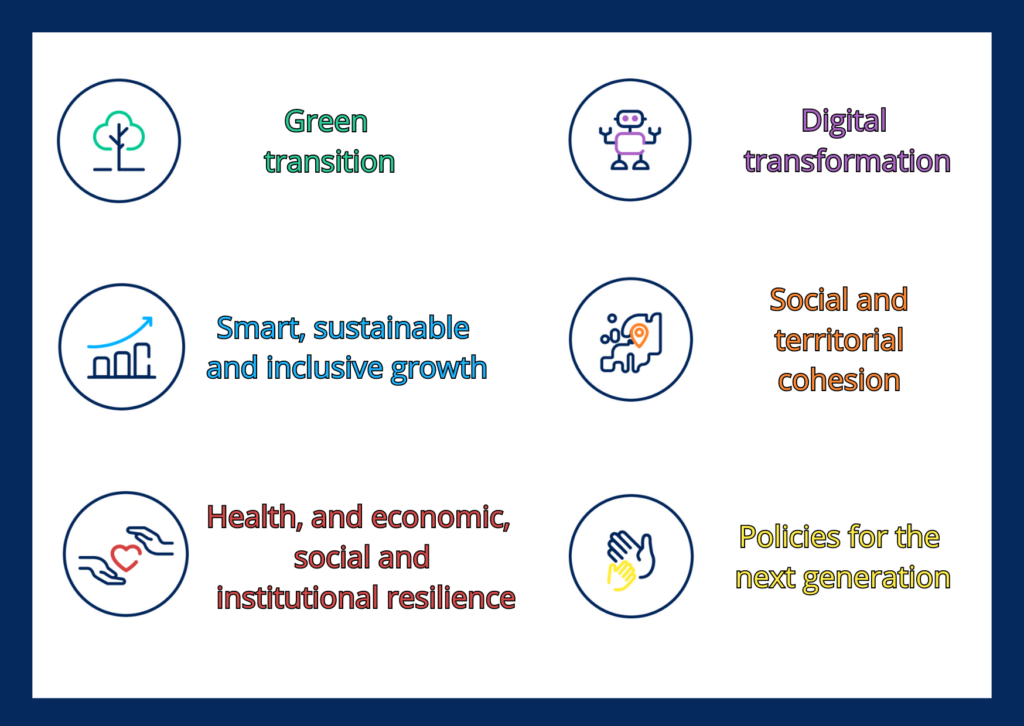The Recovery and Resilience Facility (RRF) is a €723 billion fund set up in 2021 by the European Union to help Member States recover from the economic and social consequences of the COVID-19 pandemic. The RRF is also crucial for implementing the REPowerEU plan – the Commission’s response to consequences of the war in Ukraine.
The RRF operates on a non-reimbursable basis, meaning EU funding is provided to Member States in the form of grants or loans. The grants are intended to finance projects related to six pillars:

The RRF implementation is lagging behind
The RRF is designed as a temporary fund in effect from 2021 until 2026. However, an issue that it is likely that not all the allocated money will be spent by the end of 2026. There are notably concerns that it will be the case for Italy and Poland. So far €225 billion has been disbursed to Member States which is a third of the total RRF budget.
There are multiple reasons for the delayed implementation.
Firstly, the RRF is the first example of performance-based funding, where countries must hit so-called ‘milestones and targets’, including legislative reforms and green investments, to access funds.
Secondly, disagreements between Member States and the Commission over reforms have held up payments.
It is also worth noting that, when it comes to building public infrastructures such as hospitals or schools, public procurement processes require months to be approved.
Another reason is that many governments backdated investments, in effect replacing national expenditure with EU funds — something allowed under the fund’s rules as long as these comply with its objectives, but which reduced the additional growth effect.
Moreover, as inflation rose, the cost of labour and construction materials spiked and blew planned budgets which pushed most countries to ask for revisions of the plans and budgets to take higher prices into account.
Lastly, changes in government also resulted in lengthy renegotiations of national plans, such as in Italy, delaying implementation.
The RRF is subject to fraud
RRF has long been criticised for its lack of public scrutiny which increases the funds’ vulnerability to frauds. In 2023, the European Public Prosecutor’s Office (EPPO) had 206 active investigations.
Late March 2024, authorities in Greece raided the offices of ten tech companies, including the country’s three telecommunications providers, for suspected misappropriation of €2.5 billion in RRF funds.
In April 2024, 22 individuals were arrested across Italy, Austria, Romania, and Slovakia after an investigation by EPPO and the Italian police uncovered an alleged case of RRF-related fraud totalling €600 million.
Regarding the case in Italy, according to EPPO, the suspects created and deposited false corporate balance sheets to show that the companies were active and profitable, whereas in fact they were non-active, fictious companies in order to access the RRF funds. The illicit profits have allegedly been laundered through a complex network of fictious companies, strategically established in Austria, Slovakia, and Romania.
Tony Murphy, president of the European Court of Auditors, cautioned that the fraud detected in Italy could be repeated due to insufficient central oversight and weaker controls on RRF compared to standard EU funding. He also noted that the facility’s deadline at the end of 2026 adds to the risk of fraud by increasing the pressure on Member States to quickly spend the allocated funds.
Despite these frauds’ cases, the Commission said in April 2024 that it intends to simplify Member States’ auditing and control procedures for RRF payments in order to “alleviate Member States’ administrative burden”.
How the RRF could be improved
First, it is important to mention that there is a lack of sharing of best (and worst) practices financed by RRF between Member States. Even though countries have national specificities and different targets and reforms to implement, some challenges such as the digitalisation of education are included in many National Recovery and Resilience Plans. This lack of sharing of best and worst practices means that if a mistake is made in a project in a country, it will not be shared with other Member States and can be replicated in other countries. That’s why it would be beneficial for the EU Commission to implement a framework to foster exchanges between countries on RRF implementation. As we are already more than halfway through the life expectancy of RRF (until 2026), we should be able to step-back and analyse what the fund has financed so far. So that if modifications of National Plans are needed, they can still be done. Indeed, in a time of scarce financial resources, due to inflation and a spike in defence expenditures due to the war in Ukraine, the efficiency of EU public money is more important than ever.
This is worth for RRF but also other EU funding programmes such as Erasmus+, which doesn’t only finance the mobility of students and teachers but also many European projects in the education sector.
Second, the investments that are financed by RRF should ensure that they employ Europeans and/or buy from European companies. Indeed, for instance in the area of school digitalisation where many countries use RRF to buy laptops or robots for school students, it should be ensured that the quality but also the origin from these devices benefits European economic growth. Even if non-European products are usually cheaper. The same can be said for renewable energy where several countries such as Lithuania or Belgium use RRF to build wind offshore and onshore farms, at a time where the European wind turbine sector faces fierce competition from China and the US. As it stands, there is no obligation in RRF for Member States to purchase equipment or service from a European company if it exists. However, this is a bigger issue pertaining to EU procurement rules, which are designed to ensure transparency, competition, and non-discrimination in public procurement. These rules generally prevent Member States from favouring domestic or European suppliers over those from other countries, provided that those countries are part of the World Trade Organization’s Government Procurement Agreement or have similar agreements with the EU. On a more positive tone, we can note that the recent boom in solar energy generation in Eastern Europe could be linked to investments financed by RRF.
What will happen to the RRF after 2026?
As the deadline of 2026 for RRF funding to be spent by Member States is getting closer, there is a debate in Brussels on the future of RRF, and of the likely unspent money.
The remaining money could simply be put back into the EU’s common budget, but that option is not getting much traction. From the last discussions in Brussels and the media, it seems there are 3 options on the table:
- Extension of the RRF spending deadline: Italy’s Prime Minister Georgia Meloni is trying to negociate an extension of the spending deadline. Without an extension, uncompleted investments will lose EU funding, leading municipalities to abandon projects altogether due to financial constraints. Italy could end up spending only half of its €194.4 billion allocated RRF funding.
- Make RRF a permanent scheme (having more common EU debt): the idea of making RRF a permanent fund, and therefore joint borrowing, to finance the EU’s digital and green transitions is supported by the Economy Commissioner Paolo Gentiloni and Belgium. French President Emmanuel Macron and European Central Bank President Mario Draghi also expressed support for more joint EU debt. However, this option is firmly opposed by Germany, whose constitutional court ruled in 2022 that joint EU debt for the pandemic could be allowed only as an exception.
- Changing Cohesion Policy fund to an RRF-like model: The Commission raised the prospect of turning the €392 billion cohesion fund into a money-for-reforms model. Until now, cohesion funding, which aims to boost growth in the EU’s poorer regions and narrow the gap between richer and poorer regions, has been paid according to agreed criteria rather than as a carrot for meeting targets. Moreover, until now, cohesion funding has been managed under a direct relationship between the European Commission and local authorities, in contrast to the RRF, where the EU executive deals only with central governments. EU Budget Commissioner Johannes Hahn expressed his support to make cohesion funding performance-based. But the idea is getting opposition. European Court of Auditors’ President Tony Murphy criticised the RRF’s indicators to determine performance as ‘too nebulous to be amenable to measurement”. Christophe Rouillon, rapporteur for the European Committee of the Regions, said about RRF that ‘the centralisation it brought about, as well as the deficiencies of the performance-based mechanism, cannot be extrapolated to the future cohesion policy”.
In conclusion, RRF which was an unprecedented joint effort to overcome the Covid-19 crisis and later on the Russian invasion of Ukraine, has and will yield many positive results. But it is not devoid of faults which can make it subject to fraud and inefficiency. As the 2026 deadline is coming close, its future is put into question. The next two years will be crucial to decide what will the EU do of the unspent money from RRF but also to question our current EU funding mechanisms. This crucial topic should be thoroughly addressed by EU policymakers in the next mandate.


